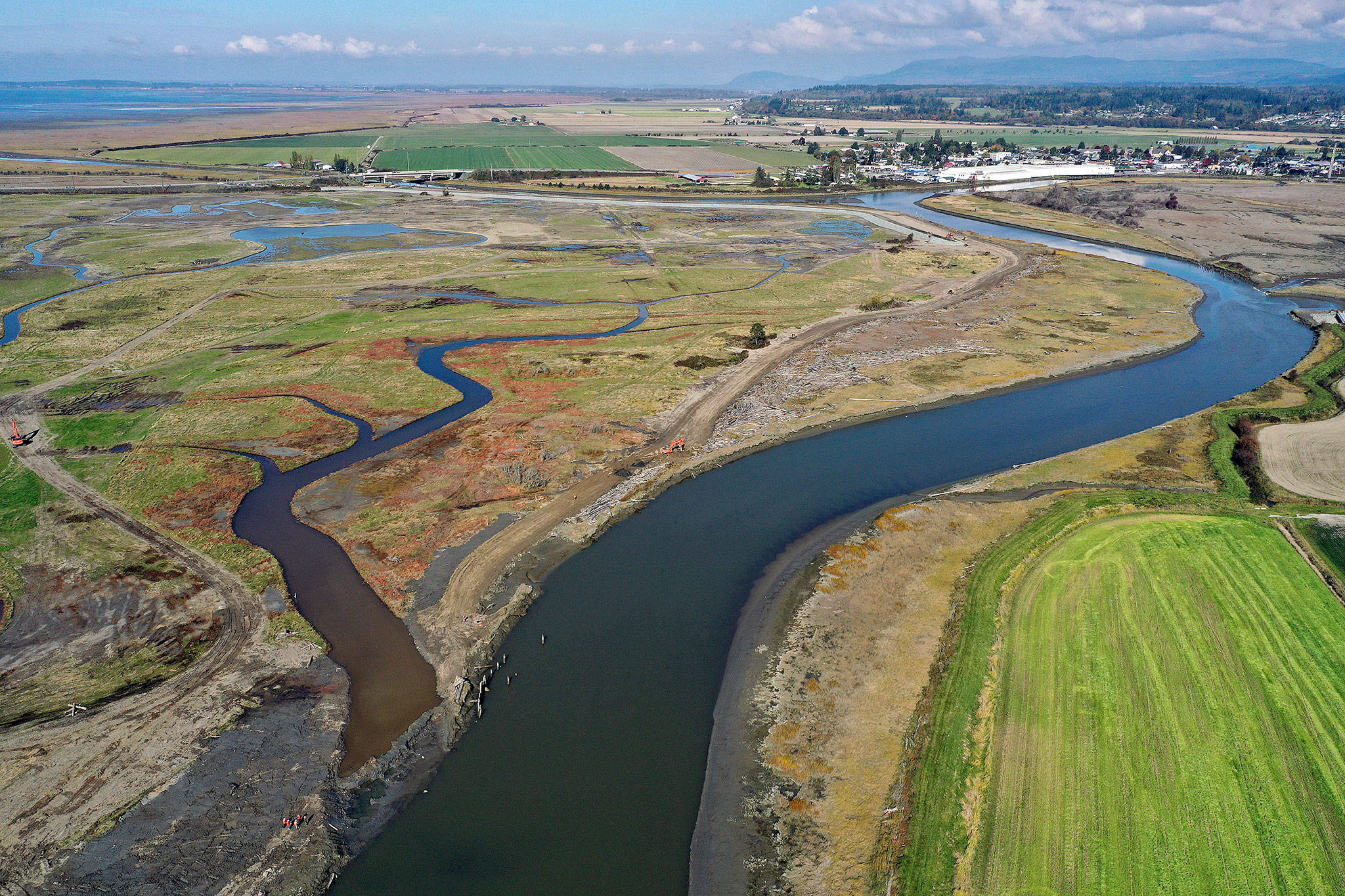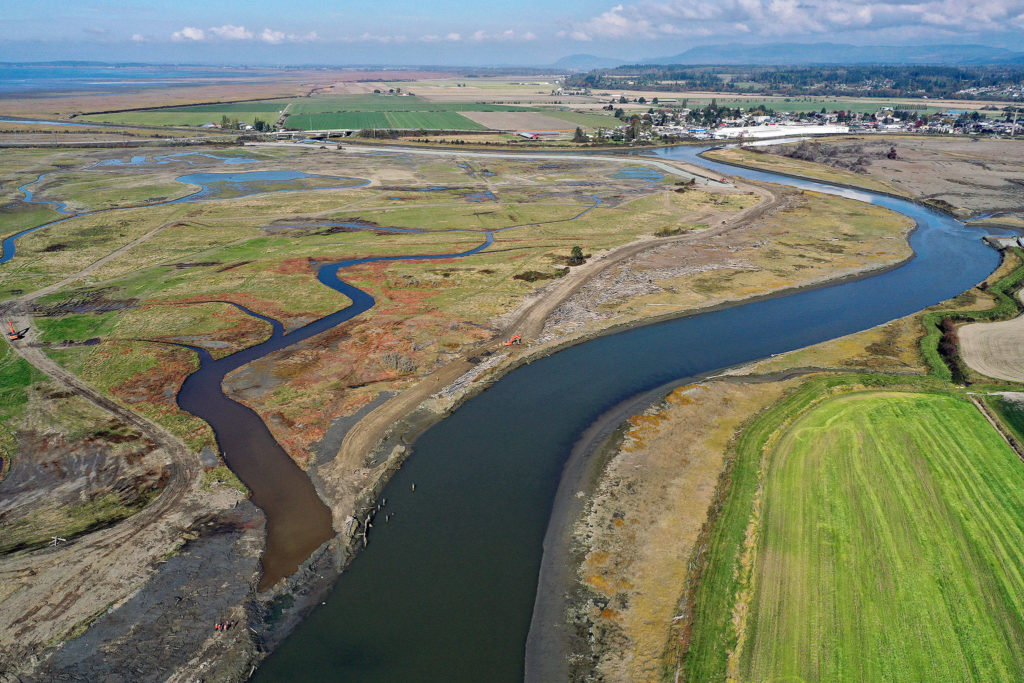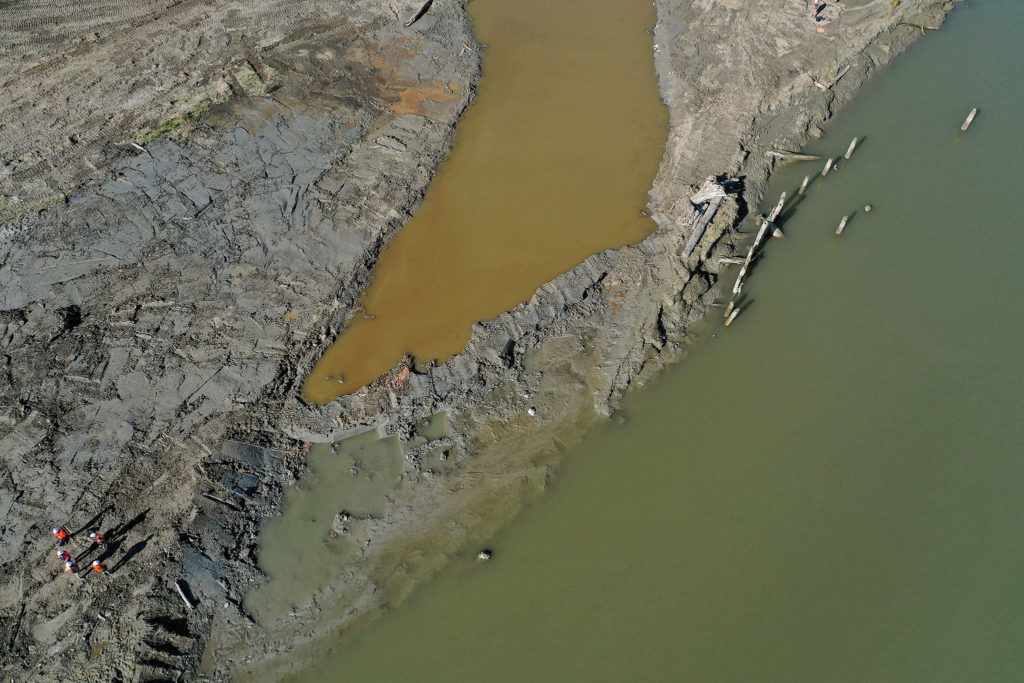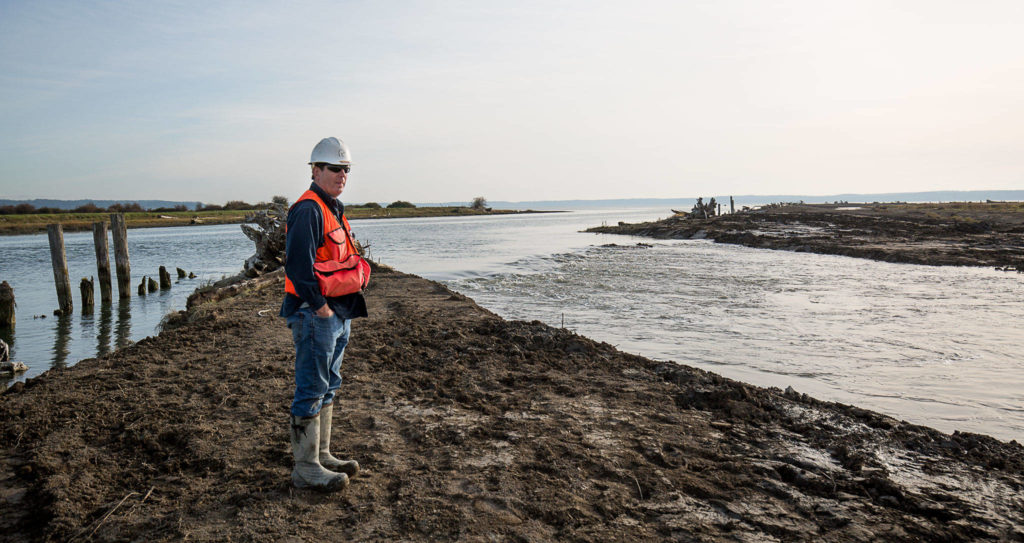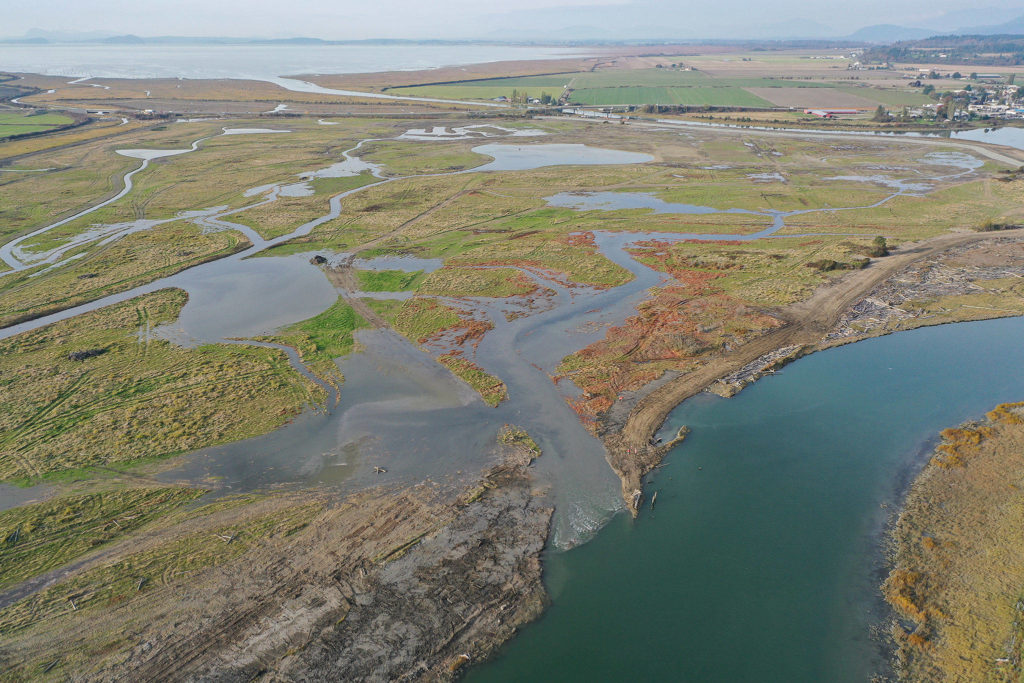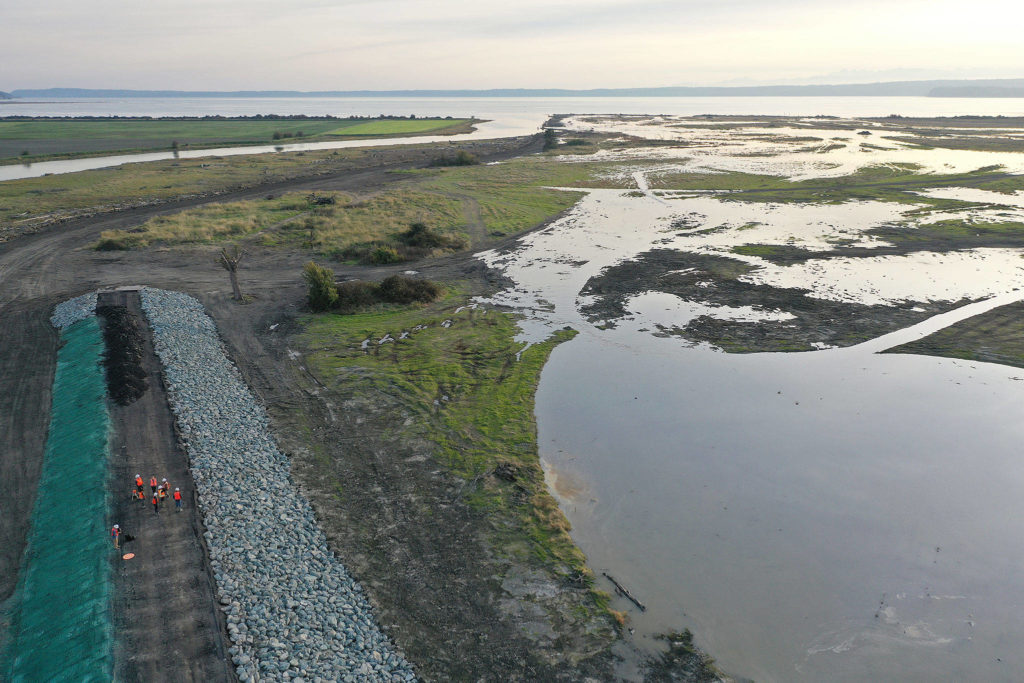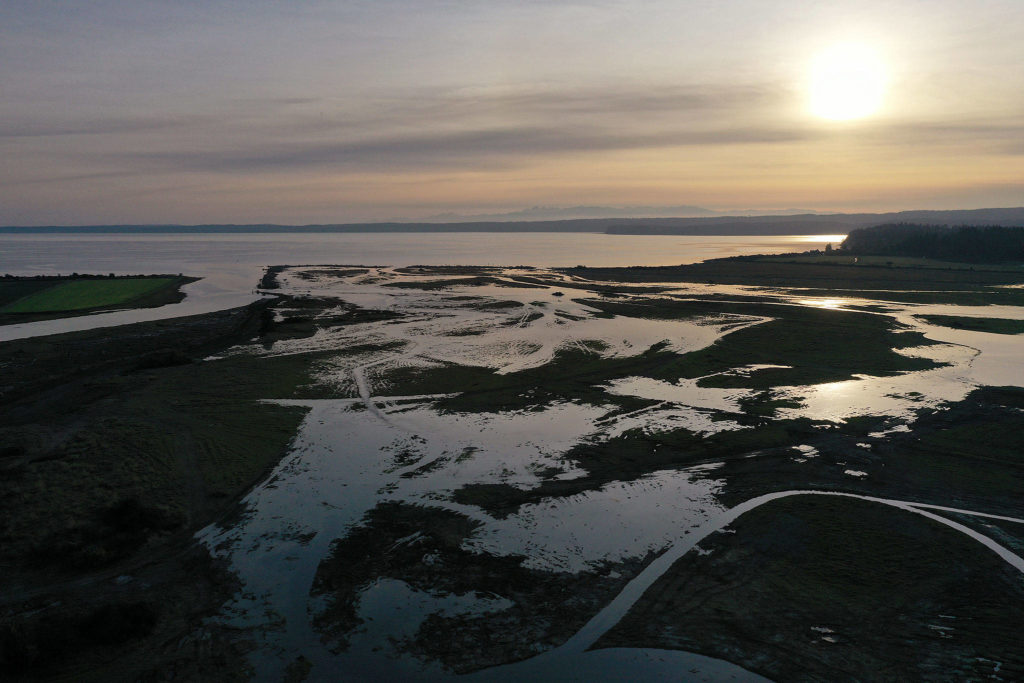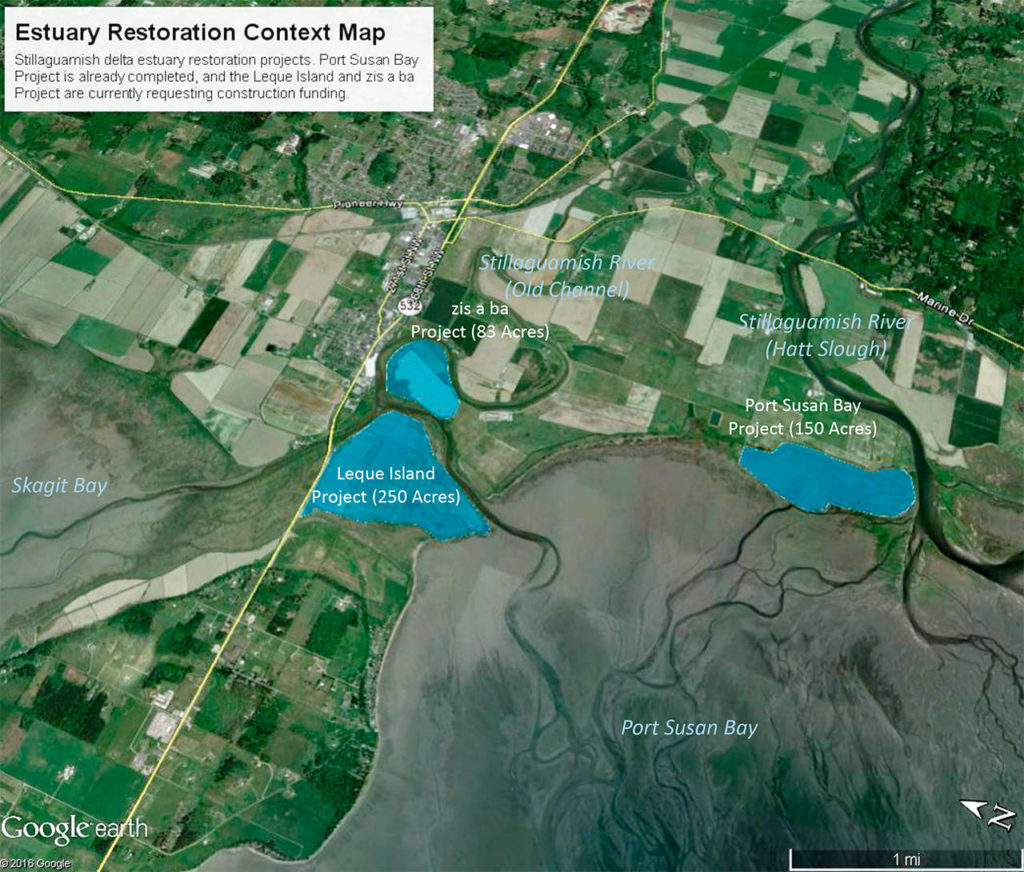STANWOOD — As the tide rose in Port Susan Monday afternoon, water inched up a dirt berm on the edge of Leque Island. Just before 5 p.m., the flow seeped over the berm’s edge, rushing into a channel that cuts through the island’s grassy plain.
It was the first time saltwater flowed naturally onto the island in over 100 years, since before the almost 300-acre swath of land was diked off for farming in the early 1900s.
The last of those dikes were removed Monday as the final step in a project to restore the land to its original state as a salt marsh.
With water now on both sides of the highway at high tide, “Camano will feel a lot more like an island,” said Loren Brokaw, restoration project coordinator for the Washington Department of Fish and Wildlife.
He’s been working on the project for about seven years.
“I remember when this was just a glimmer in our eyes,” he said, “and now it’s here.”
Without the dikes, saltwater will filter into six channels that excavators chiseled into the island and flood the area with about 2 feet of water, creating essential habitat for salmon and water fowl.
The project also adds more public access to the island — with a walking trail, two parking lots and two boat launches.
Leque Island lies on the south side of Highway 532, to the west of Stanwood on the way to Camano Island.
More than 40 years ago, the state began purchasing pieces of Leque Island, intending to focus on farming grain for waterfowl but later turning its attention toward estuary restoration. The agency now owns all of Leque.
Until about five years ago, contract farmers planted cereal grain to feed wintering waterfowl. Farming has since ceased. The area has become a popular spot for hunting, bird-watching and bird dog training.
The former dikes had been been failing for years, according to the Department of Fish and Wildlife. They’ve given way during high tides and storms. Temporary patchwork has been done, but repairs were expensive and breaches were a recurring problem.
Officials started looking at options for either removing or repairing Leque Island’s levees in the early 2000s, and the state Salmon Recovery Funding Board supported the effort with grants in 2004 and 2007. A plan that would have removed levees around half the island and repaired the rest was in the works in 2005 when concerns about saltwater intrusion into a Camano Island aquifer stalled the project.
The Environmental Protection Agency ruled that removing the levees wouldn’t pose a threat to the freshwater aquifer, and the Department of Fish and Wildlife returned to the project in 2013. Planners formed a 31-member volunteer advisory committee and held public meetings to gather questions, concerns and suggestions. The committee had representatives from groups that have repeatedly opposed removing dikes around the island. Opponents included the Washington Waterfowl Association and Camano Water Systems Association.
Kevin Plambeck, president of the Juniper Beach Water District on Camano, said the district would have preferred a plan that floods less of Leque.
“We’re still concerned about the aquifer and the saltwater,” he said. “That’s never diminished or changed.”
The project cost about $6 million.
As Leque Island flooded Monday, a pair of ducks made themselves at home on a newly formed pond. The island will continue to flood twice a day, and the water will begin to change the land as it forms small channels and settles into low spots. The habitat will also begin to transform as freshwater plants die off and are replaced by sedges and rushes.
These changes will take years, but fish will begin using the site almost immediately, Ducks Unlimited biologist C.K. Eidem said.
Estuary habitat is one of the most important factors in a juvenile salmon reaching adulthood, he said.
“If you’re making a sandwich and you have 10 pieces of bread but two pieces of baloney, you can only make two baloney sandwiches,” Eidem said. “The limiting factor is the baloney. For Chinook, the limiting factor is the amount of rearing habitat.”
The Leque Island restoration will also support waterfowl and migratory birds, but the focus is on Chinook salmon, Brokaw said.
As Chinook come out of the river, it’s not good for them to immediately go out into the saltwater bay. They’re too small, and have a good chance of getting eaten, Brokaw said.
Now, the juvenile fish can spend several months hanging out in the estuary, feasting on a rich food supply and getting larger quickly.
The area will be used by fish from the Skagit, Snohomish and Stillaguamish rivers, department habitat biologist Lindsey Desmul said.
Leque Island has the potential to support thousands of juvenile salmon.
The restored 200-acre Fir Island estuary in Skagit County supports 50,000 to 65,000 baby fish, but Brokaw said that’s not an indication of how many will take up residence on Leque Island.
As excavators zipped around making finishing touches early Monday, eagles and hawks began to circle the sky.
“They know a vole exodus is about to happen,” Eidem said.
The raptors remember when small critters scurried away from the flooding next door at zis a ba, an 83-acre estuary that was restored in 2017 by the Stillaguamish Tribe.
Leque Island is one of three restoration projects in the Stillaguamish watershed, including zis a ba and another Port Susan site.
Similar work is happening regionwide, with big projects on Smith Island and other tidally influenced areas in the Snohomish River delta.
The Leque Island project will have benefits for human visitors as well.
Along the northeast portion of the area there is now a .7 mile-long berm with a walking trail instead of Eide Road and a brush-lined dike. Without a dike blocking the line of sight, views of Stanwood and the Cascade peaks of Whitehorse mountain, Three Fingers and Mount Pilchuck are now visible.
The berm also acts as a wave barrier to protect Stanwood from from extreme weather, which can create waves up to 5 feet.
There are two new boat launches. One is upriver to the east, where the department partnered with Stanwood to build a motorized boat launch near the Hamilton smokestack. On the west side of the project, there’s a new parking lot with a non-motorized boat launch. There’s also a parking lot at the head of the berm trail, where the old Eide Road was.
Public access should be open in about a week, Brokaw said.
Ducks Unlimited engineer Steve Liske has worked on the Leque Island project for a decade. He spent Monday camped out at the site waiting for it to flood.
Although he likened waiting for high tide to watching paint dry, he could see his work come to fruition as water filled each of the six engineered channels.
“It’s amazing,” he said.
Moving forward, the project site will take care of itself. All that’s left to do is monitor its natural transition and track how wildlife changes.
By spring, department communications manager Seth Ballhorn said officials expect to see juvenile Chinook there gaining strength and growing bigger.
Julia-Grace Sanders: 425-339-3439; jgsanders@heraldnet.com.
Talk to us
> Give us your news tips.
> Send us a letter to the editor.
> More Herald contact information.
